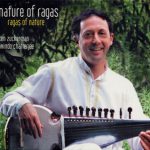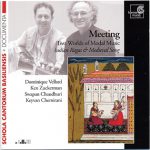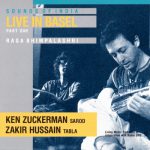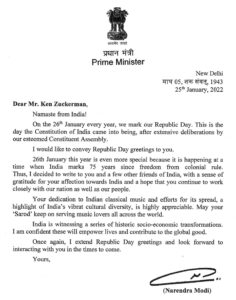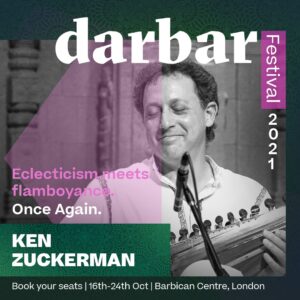Two Instrumentalists on a Silver Morning
It was a Sunday. Getting out of the sleepy mood of winter Sunday morning, we were caught in the environment of melodies. This music conference was organized by “Rupak” (means silver), an institution of classical music.
There were two artists in this conference called by Rupak. One was Sri Dhrubajyoti Chakraborty on sitar, accompanied on tabla by Sri Bablu Pal. The other one was the American Mr. Ken Zuckerman, who played sarod, accompanied on tabla by noted artist Pandit Swapan Chaudhuri…
Later after the interval, who appeared on the stage was not an Indian. But his so facile and smooth capacity in performing Indian traditional music may not be found even amongst many Indians. Ken Zuckerman is a competent student of Ali Akbar Khan. Giving performances in several conferences around the countries of the world the name of Ken Zuckerman has become a shining appearance. At present he is the director of the Ali Akbar College in Switzerland. On that morning he played raag Nat Bhairo. The exact arrangements of ragas impressed the interested audience. The artist’s keen and faultless timing expression fascinated the audience. This foreign artist set a resulted example of 20 years long of devoted practice and learning of music. Of course his play became more appealing through Swapan Chaudhuri’s tabla accompaniment. He presented us a very enjoyable morning through and through by this wonderful duet performance. Certainly thanks go to “rupak” for this conference.
Calcutta, Aparna Mazumdar, January 1998
Ken Zuckerman started with Bageshree Kanra. It is of great amazement how a person who is not from any kind of atmosphere and a background of the Indian culture, falls in love with an Indian instrument and masters its technique to the perfection. What’s outstanding is how a person from a different emotional atmosphere creates a soulful relation with the raag.
A complete mastery over the instrument, pure raag structure and note sustenance are the great qualities of this artiste. And it is remarkable how he has earned it with his great devotion and discipline.
He started with Bageshree Kanra and played compositions in Vilambit, Madhyalaya and drut tempos. And then he played a melodious dhun in raag Bhoop Mand, displaying a sonorous aspect of music. The attractive and powerful accompaniment of Mr. Vijay Ghate was a plus.
Sakal, Pune, December 15, 2003
Zuckerman Awoke an Unparalled Magic of Musical Notes
The welcome to the New Year could not have been better – a tasteful painting and sculpture exhibition and a melodious sarod recital in a spiritual evening. Young sarod maestro Ken Zuckerman had come to Indore from Switzerland. He is a disciple of Ustad Ali Akbar Khan and is also the principal of the Ustad Ali Akbar Khan music school in Basel, Switzerland.
Ken Zuckerman produced music of such depth and quality that yesterday’s program is now a part of our treasured memories. Hitendra Dixit, who is in his youth, accompanied Ken on tabla. His playing has proved that he is a tabla player of national status and will be widely acclaimed. His future is full of bright prospects.
Zuckerman started his recital with raag Pooriya Dhananshree. His soft notes and light hand made each aspect of the sarod glimmer with a sheen. The resounding preamble alaap itself, transported the audience to an idyllic world where Zuckerman awoke the beauty of the raag. Ustad Ali Akbar Khan’s able disciple presented intricacies like meend, gamak, jhala, etc. in his rendering. Hitendra also displayed his control over the slow, medium and fast pace in accompaniment, which is highly laudable. Through his crystal clear recital of the raag’s complicated intricacies, Zuckerman found inroads into the depth of musical enchantment. This initiated the synthesis of beauty and emotional appeal.
Zuckerman’s next performance was raag Kafi, set in six beats. Though a raag of simple nature, Zuckerman’s touch filled it with an exuberance which endeared the audience. The tempo was sometimes slow and sometimes fast, and Hitendra’s accompaniment facilitated in beautifying the raag further.
Next Zuckerman played raag Chandranandan, which has been composed by his guruji Ustad Ali Akbar Khan. The audience was enthralled by the expansion and subtle facets of the raag through its presentation. Here Hitendra assisted by his creative support.
The music programme concluded with the beautiful raag Bhairavi. Hitendra’s swift fingers and forceful punctuations gave a new life and meaning to this raag. He seems to be a person with considerable self confidence and should have a great future – an upcoming star in the national music scene.
This program was organized by the Alumni Association committee of Devlalikar to celebrate the New Year, along with an art exhibition. They deserve our congratulations.
Navbharat, Indore, Sadna Devesh, Jan. 5, 1999
Mellow Sounds of Rhythmic Raag
Nature of Ragas, Cramphorn Theatre, Chelmsford, Essex, Sunday July 7, 2002
Raag Hemant, an evening raag, began with “alap”(the overture), a slow, developing movement. Ken Zuckerman on the sarod (a fretless stringed instrument) soon created the right atmosphere and mood. This was gently and almost imperceptibly followed by the more complex “jodh”, still a solo exposition but where a rhythmic pulse was introduced and the tempo increased.
Out of this evolved “gat”- a composition of the raag played in a rhythmic cycle. Anindo Chatterjee on tabla gently entered at this stage to provide the rhythm, when both players took adequate opportunities to improvise and show their judicious and dexterous skills, and a deep respect for each other.
The gats were performed in different tempos from slow to fast and new moods were evoked by the developing raag, changing and evolving to elevate the audience into spectacular flights of fancy.
Ken’s years of being a disciple of the great Ustad Ali Akbar Khan came tumbling out as his playing of the sarod, an instrument of much finesse, produced the springtime music of joy and peace.
The playing was truly refreshing, creative and accomplished. There were smiles all around.
After the interval, they played a late night Raag Chandranandan, composed by none other than Ustad Ali Akbar Khan, from their new exciting album “Nature of Ragas”, a delicate melody dedicated to the full moon. It was performed with inspiring mellowness. Variations showed the width and depth of Ken’s talent in cultivating aesthetically pleasing and romantic emotions. Here was a master who had fully harnessed the power of the sarod – the finest of sarod players outside India – an American now living in Switzerland. After a standing ovation and an encore, Ken treated us to yet another enlightening and delightful raag. It was pure magic.
East Anglian Daily Times, Rasik Bhadresa, Monday, July 15, 2002
Ali Akbar’s Skill in the Hands of a Foreigner
Ken Zuckerman, the foreign student of Ustad Ali Akbar Khan, was the main attraction of the Musical Soiree organized by ‘Rupak’ at Jnan Mancha. His 22 minute alap-jod and 19 minute gatkari in the rag Kausi Kanada were no way inferior to any of his contemporary players of the Ali Akbar School. It was also especially remarkable that in his Koushi Kanara there was the presence of the pure Ali Akbar mood. His control over the rag was an indication of good learning. Likewise, the deep musical sentiment that was there in his vistara of the padas in the alap is the proof of a class artist. The alap, whether small or big, of some artists remains, as it were, divided into several parts where it is easily intelligible that one section is complete and the next is beginning. Then there are others, whose alap continues from the beginning in an uninterrupted natural flow, just like an extended song. Zuckerman’s was of the second type. No one could realize when, with the production of pada after pada he arrived at and settled into the sadaj of the tara-saptak, then immediately beginning with the antara portion. The fun grew more when mild rhythm was added with the padavistar of jod. Some effects of bida, which also appeared on and off during the alap, were now proposed. Towards the end, Zuckerman skilfully played several tan-toda employing more than one string, in the style of Ali Akbar Khan during his middle age.
The primary rhythm of the bilambit-tintal-gatkari was brief and a little perfunctorily done. Zuckerman was perhaps concentrating on letting the reputed tabalist Swapan Choudhuri present his bol material. Later, he of course did the works of chanda bolkari-tantoda well and earned a lot of clapping. The bandish of the drut tintal was of the Alauddinkhani type and Zuckerman played good rhythmic bandish-vistar tukra and tan-toda in this part. Swapan Chaudhuri drew more applause as he played drut gatkari, especially when one jawab played valiantly by him dashed into sum. Even if Zuckerman’s work of jhala was brief it was, nevertheless, substantially of the Aliakbari style.
Lastly, the artist played two gats in a rag like Gorakh Kalyan. I am saying ‘like Gorakh Kalyan’ because the Gorakh Kalyan that I have heard recently uses pancham swar in some moments but not as much as being employed here. Perhaps Ali Akbar’s Gorakh Kalyan is of this type – I never heard him playing this rag. Zuckerman used the padas re ma pa and ni dha pa ma re sa regularly. The first pad is sometimes being used in a manner in the Gorakh Kalyan which I have been hearing in Khayal songs but not the second. However, in this part, the artist aptly played good works of Aliakbari gatkari bol with chanda. He did not play jhala in the end.
Desh, Calcutta, Nilaksha Gupta, February 1999
Zuckerman Does Ali Akbar Khan Proud with Sarod Recital
Ken Zuckerman, an American by birth, Swiss by domicile and Indian to the core of his soul, played his heart out in a virtuoso performance that would have warmed the cockles of his guru Ustad Ali Akbar Khan.
Central Chronicle, Bhopal, Jan. 7, 2004
Rewarding Variety of Melodies
This year’s Bhowanipore Sangeet Sammelan was conspicuous for a sarod recital by Ken Zuckerman, the US-based student of Ustad Ali Akbar Khan, and a vocal recital by Sandipan Samajpati. This time Ken showed an authentic grasp over the subtleties of the Maihar gharana, sustaining the dhrupadi characteristics of the school. He played Chhayanat and established the imageries of the “raagrup” and then captured both the lively and somber moods of the following item.
The Statesman, Calcutta, April 6, 2001
Zuckerman shows his mastery over Sarod
It was a very pleasing experience to watch Switzerland’s well-known sarod player giving his solo programme at Bharat Bhavan under the “Rag Ras” concert on Friday. “Rag Ras” was organized by Madhya Pradesh Sanskritik Sansthan and Bharat Bhavan jointly here on Friday.
Internationally acclaimed sarod player Ken Zuckerman is the main disciple of leading musician Ustad Ali Akbar Khan. His rigorous riyaz of sarod was obviously seen in his performance. He has received appreciation from all major cities in India and Europe where he performed. At present, he is director of the Ali Akbar Khan College of Music in Switzerland.
He commenced his solo sarod playing with rag Madhuvanti in which he played alap, jod, jhala and gat, and kept the audience spellbound by exhibiting his command over the sarod and made the raga more sweet and delicious through his distinguished style, somewhat reminding about the playing style of his guru Ustad Ali Akbar Khan. The fine and decorated tans and elaboration of raga with its full aesthetic values and charm impressed the music connoisseurs of the city.
However, after appearing on the stage, he took some time to tune in and making the mood for the raga which he produced with full aplomb. He is these days on tour of India and had planned to give the sarod recitals across the country. His daughter was also with him during his performance. The peculiar feature of his performance is that he is able to play the odd “Tals” of 12, 14 and 10 matras, that is considered a difficult task for an instrumentalist.
Central Chronicle, Bhopal December 28, 2002
Global Maihar
Ken Zuckerman enthralled his audience in a special event organised by the Sree Satyananda Mahapeeth at the ashram premises. ….All of this was evident in the emotive mood of this sarod player who mastered the techniques of Maihar gharana. With extremely loving, gentle strokes immersed in different melodious shades of imaginative improvisations he delineated the distinct features of Kaushi Kanada.
The Statesman, Calcutta, February 27, 2004
An exceptional sarod recital and a beautiful tabla accompaniment by Ken Zuckerman and Anindo Chatterjee was an appropriate offering for the birthday celebration of Swami Vivekananda, organised by Satyananda Mahapeeth, on January 13. The torch-bearer of Maihar gharana, Ken, in his presentation of Kaushi-Kanada, unravelled the nostalgic pathos of the raga through alap, jor, gat in trital, extensive meends, outstanding ghasits, gamak, rhythmic variations in both Masidkhani and drut gat along with jhala and clear tankari. Compositions in Durgeswari were of same stature. Anindo was controlled yet decorous and the performer-duo perfectly complemented each other.
Anuradha Sanyal, Jan. 23, 2004 Telegraph, Calcutta
Nature in Sound
Music in harmony with nature – in the truest sense of the word ‚harmony’: this is classical Indian music. When Ken Zuckerman plays his sarod, an instrument from the same family as the sitar, he is at peace within himself. One can hear and feel this. At the ‘Schlosskonzerte’ Thun, he introduced the Indian way of life and culture to the Thuner audience, in the Rittersaal. The American appears to be just as Indian as his tabla playing colleague Anindo Chatterjee. The Ragas – defined sequences of notes within which the musician can improvise – each reflect an aspect of nature and represent a mood. The repetitive sounds have a calm and transcendent effect – almost meditative. The two tanpura players, Sunita Asnani and Amelie Berner, wove the sensitive sound carpet on which sarod and tabla unfolded the music. Classical Indian music is modal, and it develops in rhythmic stages. Although there is no melody in the European sense, Zuckerman’s melodic sequences generated a trance-like attraction and the gliding ornaments and vibrati seemed to develop naturally from one another.
The century old ragas are so close to nature in a way that our music has not been since ages. They have something magic – a music that enables one to explore one’s roots, to find the inner self. Just as Ken Zuckerman obviously did.
Zeitung im Espace Mittelland, Maria Kanzli, Friday, June 27, 2003
SF Gate: Hesperion XXI Leaps Centuries, Border
There may be a few greater early music experiences than Spain’s eight-member Hesperion XXI, but there are none that go about advertising their greatness so quietly. Back in the East Bay for the first time since 1998, Jordi Savall’s captivating team made the most of its uniquely delicate magic Friday evening in the Berkeley’s First Congregational Church……..
This was a veritable king’s ransom of musical discovery; and when Zuckerman launched a duet with Estevan, the sarod and percussion reaffirmed a shining truth – music dissolves national borders in a way the treaties cannot.
SF Chronicle, Allan Ulrich, Chronicle Music Critic, March 19, 2001

